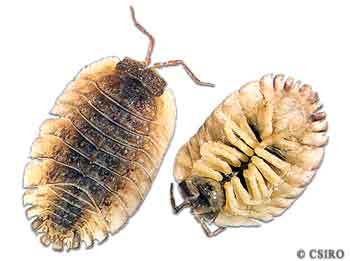|
Isopoda:
slaters
Characteristics
Isopods
vary greatly in appearance and are common inhabitants of many environments.
Slaters belong to the very large phylum of Crustacea of which most
are marine dwellers and includes such groups as amphipods, beach
hoppers, shrimp, crabs, lobsters, crayfish as well as isopods. Slaters
are one of two groups of Crustacea that have become terrestrial.
Slaters are the most conspicuous and are easily recognised by their
heavily armoured, flattened bodies. Most species are grey in colour
although some may have a pink hue. Slaters may range in size but
are usually less than 15 millimetres in length. Their characteristics
include:

Isopod species (slaters) |
|
- 1 pair of
prominent antennae and 1 pair of inconspicuous antennae
- Simple or
compound eyes composed of either single ocellus or many closely
associated ocelli respectively
Life Cycle
In slaters
the male transfers a sperm packet to the female using his modified
seventh legs. The eggs, of which there may be up to 100 or more
are laid into a brood pouch which is a chamber formed by cuticle
outgrowths at the base of the legs. Upon emerging from the brood
pouch the young resemble adults but have only 6 body segments and
6 pairs of legs. They will gain their last segment and seventh pair
of legs at later moults.
Slaters moult
in two separate stages, with the first half of the body shed, then
a couple of days later the second half is shed.
Feeding
Slaters
are omnivores
or scavengers
and feed upon decaying vegetable matter and associated fungi and
also on animal matter. They form an important link in the food chain
by recycling dead and decaying matter.
Habitat
Slaters
mostly inhabit moist areas and are commonly found under rocks and
logs, in leaf litter in forested areas and in the garden. Some species
are found in the semiarid regions of inland Australia and several
introduced species are common inhabitants of suburban areas commonly
living in compost heaps and other moist situations.
|